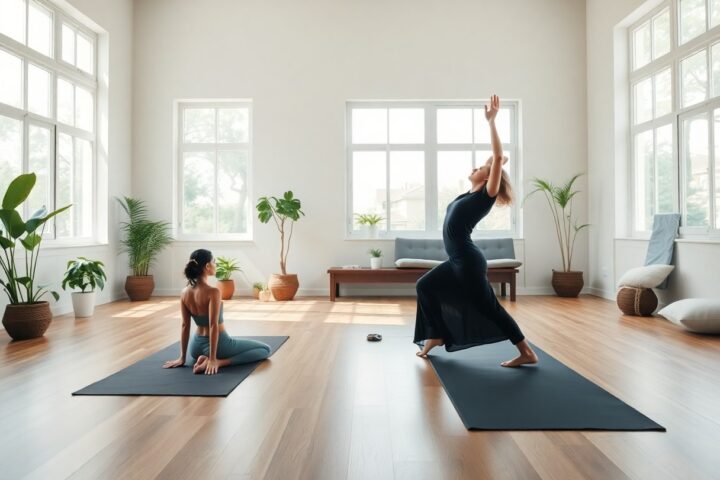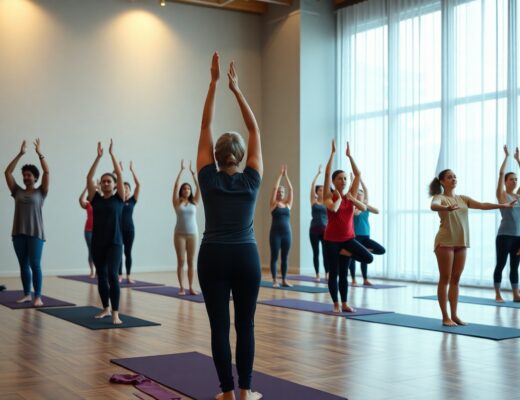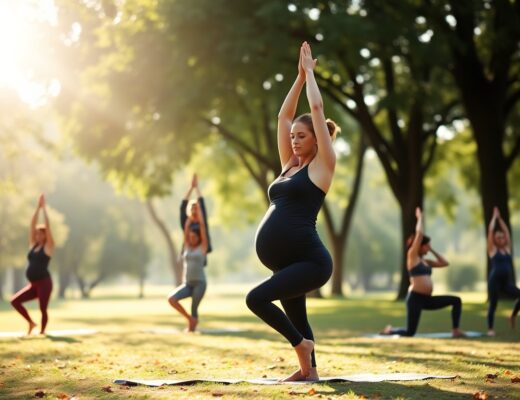Difference in practice styles is important when determining which yoga form suits your needs best. Yin Yoga offers a slow-paced approach, focusing on deep stretching and holding postures for extended periods to cultivate flexibility and mindfulness. In contrast, Vinyasa Yoga is dynamic, linking breath with fluid movements, promoting strength and cardiovascular endurance. Understanding these differences can help you choose the right practice for your body and mind’s needs, creating a more rewarding yoga journey.
Overview of Yin Yoga
While Yin Yoga is a slow-paced style that focuses on holding postures for extended periods, typically between three to five minutes. This practice targets the deep connective tissues and fascia, promoting flexibility and joint health. Unlike more dynamic yoga styles, Yin encourages an inward focus, allowing you to cultivate mindfulness and surrender to the poses. You’ll find that this meditative approach not only enhances physical benefits but also nurtures emotional balance and inner peace.
Origins and Philosophy
Against the backdrop of traditional Chinese medicine, Yin Yoga draws inspiration from ancient philosophies that emphasize balancing the body’s energies. Rooted in Taoist practices, it seeks to harmonize the Yin and Yang forces, underscoring the importance of stillness and introspection. This philosophical foundation invites you to explore the deeper aspects of your being while nurturing the restorative qualities of your body.
Benefits of Yin Yoga
Across various aspects of physical and mental well-being, Yin Yoga offers numerous benefits. This practice is particularly effective for increasing flexibility, improving joint mobility, and releasing tension in the deep connective tissues. In addition, it fosters a sense of relaxation and mental clarity, helping you navigate daily stressors with greater ease.
Hence, you can expect enhanced circulation and improved energy flow throughout your body as you engage in Yin Yoga. This gentle practice can also support better emotional health by encouraging mindfulness and self-reflection. As you hold each pose, you’re provided with the opportunity to observe your thoughts and feelings, promoting a deeper connection to yourself. Over time, this nurturing environment cultivates resilience, making it an integral part of your holistic wellness journey.
Overview of Vinyasa Yoga
There’s a dynamic flow to Vinyasa Yoga, characterized by the seamless transition between poses synchronized with breath. Unlike static yoga styles, Vinyasa offers a more energetic and creative experience, often allowing instructors the freedom to design unique sequences. This practice not only builds strength and flexibility but also connects you to the rhythm of your body and breath, promoting a meditative state of mind as you move fluidly through various asanas.
History and Development
Development of Vinyasa Yoga can be traced back to the early 20th century when influential figures like Sri Krishnamacharya and his students introduced dynamic styles of practice. Combining elements from traditional Hatha Yoga with flowing movements, Vinyasa became a popular choice for those seeking an active and engaging form of yoga. Over the years, it has evolved into various styles, each emphasizing the integration of breath with movement, making it accessible to practitioners of all levels.
Benefits of Vinyasa Yoga
Yoga in its Vinyasa form provides a multitude of benefits, from enhanced physical fitness to improved mental clarity. As you move through the sequences, you increase your strength, flexibility, and stamina while calming your mind and reducing stress. The consistency of breath and movement fosters a deeper awareness of your body, helping you to cultivate mindfulness both on and off the mat.
Further, engaging in Vinyasa Yoga can significantly boost your cardiovascular health due to the continuous movement and increased heart rate during practice. It also alleviates tension in your body by promoting relaxation and mindfulness that can carry into your daily life. Regular practice not only enhances your physical well-being but also fosters emotional resilience, making it an ideal choice for anyone looking to achieve balance and harmony in their life.
Key Differences Between Yin and Vinyasa Yoga
One of the primary distinctions between Yin and Vinyasa Yoga lies in their overall practice styles. Yin Yoga focuses on long-held, passive postures to target deep connective tissues, enhancing flexibility and relaxation. In contrast, Vinyasa Yoga is characterized by a dynamic sequence of flowing movements synchronized with your breath. This creates a more energetic practice that emphasizes strength and cardiovascular fitness, catering to different physical and mental benefits.
Pacing and Flow
Below, you’ll find that the pacing of Yin and Vinyasa Yoga diverges significantly. While Vinyasa classes feature a continuous flow of poses at an energetic pace, encouraging movement and cardiovascular health, Yin adopts a slow, deliberate approach. In Yin, you hold poses for several minutes, allowing for a meditative experience and deep stretching, which invites introspection and mindfulness.
Focus on Breath and Movement
On the other hand, both practices have unique approaches to breath and movement. In Vinyasa Yoga, your breath guides each movement, creating a rhythmic flow that keeps you engaged and energized. Conversely, during Yin Yoga, your focus shifts to holding positions for extended periods, allowing you to breathe deeply and mindfully into the stretch without the pressure of moving continuously.
A significant aspect of Vinyasa Yoga lies in the synchronization of breath with each movement. This emphasis on breath fosters a sense of connection and rhythm, providing you with an invigorating experience. In stark contrast, Yin Yoga encourages you to slow down, inviting you to observe your breath while holding postures. This mindfulness promotes relaxation and enhances your ability to listen to your body’s needs, offering a deeper understanding of tension and release within your physical and emotional states.
Target Audience and Practice Style
Many yogis find themselves drawn to either Yin or Vinyasa Yoga based on their unique preferences and goals. Yin Yoga appeals to those seeking deep relaxation, flexibility, and a meditative experience, while Vinyasa Yoga targets individuals who enjoy a dynamic flow and a more physically engaging practice. Understanding your body, energy levels, and personal objectives can guide you in choosing the practice that resonates most with you.
Who Should Practice Yin Yoga?
Below are some key indicators that Yin Yoga may be right for you. If you are looking for a slower-paced, more introspective practice that emphasizes deep stretching and mindfulness, this style may be ideal. It is particularly beneficial for individuals wanting to alleviate stress, enhance flexibility, or connect more profoundly with their breath and consciousness.
Who Should Practice Vinyasa Yoga?
The Vinyasa flow may suit you if you thrive in a more energetic and dynamic environment. This style is perfect for practitioners who enjoy combining movement with breath, seeking both physical challenge and creative expression in their practice. If you prefer a fast-paced workout that builds strength and endurance while also promoting a sense of flow, Vinyasa Yoga invites you to explore your body’s capabilities.
Style and pace are vital when considering Vinyasa Yoga. This practice is characterized by its continuous flow from one pose to the next, often set to music, creating an invigorating atmosphere. Ideal for those who like to break a sweat while cultivating mindfulness, Vinyasa enables you to synchronize movement and breath, thereby fostering a deeper connection between body and mind, suited for those eager for both physical exercise and personal growth.
When to Choose Each Style
Your decision to practice Yin Yoga or Vinyasa Yoga can depend on your mood and physical state. If you’re looking for deep relaxation and mental clarity, Yin Yoga is an excellent choice. Conversely, if you prefer a more vigorous workout or have a desire to build strength and flexibility, Vinyasa Yoga may be the better option for you. Understanding when to choose each style can enhance your overall yoga experience and meet your personal wellness goals.
Yin Yoga for Stress Relief
Below is a gentle, restorative practice that focuses on holding poses for an extended period, which helps to release tension in the body and calm the mind. It is particularly beneficial for those who find themselves under stress, allowing you to unwind and create a sense of inner peace. If you’re feeling overwhelmed, Yin Yoga provides a soothing environment where you can reconnect with your breath and let go of daily pressures.
Vinyasa Yoga for Dynamic Movement
By incorporating a flowing sequence of poses, Vinyasa Yoga keeps you engaged and active throughout your session. This style emphasizes movement with breath and can serve as both a workout and a meditative practice. You’ll enjoy a high-energy atmosphere that encourages you to explore your physical limits while improving strength, flexibility, and balance.
In fact, Vinyasa Yoga can be tailored to your fitness level, making it perfect for beginners and seasoned practitioners alike. The dynamic nature of this practice helps you build endurance and develop a deeper connection between your mind and body. Classes often feature creative sequences that keep the practice fresh and exciting, motivating you to enhance your overall physical performance while also providing a mental challenge.
To wrap up
Taking this into account, understanding the differences between Yin Yoga and Vinyasa Yoga can greatly enhance your practice and personal growth. Yin Yoga focuses on deep stretching and relaxation, providing time for introspection, while Vinyasa Yoga emphasizes fluid movement and energy flow. By exploring both styles, you can find the perfect balance between active and passive practices that cater to your individual needs and goals. Embracing these contrasting approaches will guide you towards a more comprehensive and fulfilling yoga experience.



